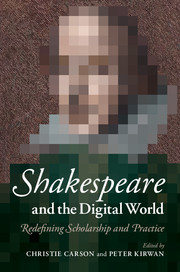Book contents
- Frontmatter
- Contents
- Notes on contributors
- Acknowledgements
- Shakespeare and the digital world
- Part I Defining current digital scholarship and practice
- 1 Shakespeare in the digital humanities
- 2 Getting back to the library, getting back to the body
- 3 Sensing the past
- 4 Webs of engagement
- Part II Defining current digital scholarship and practice
- Half-time: A pause for reflection
- Part III Redefining the boundaries and practices of Shakespeare studies online
- Part IV Redefining the boundaries and practices of Shakespeare studies online
- Index
- References
1 - Shakespeare in the digital humanities
Published online by Cambridge University Press: 05 July 2014
- Frontmatter
- Contents
- Notes on contributors
- Acknowledgements
- Shakespeare and the digital world
- Part I Defining current digital scholarship and practice
- 1 Shakespeare in the digital humanities
- 2 Getting back to the library, getting back to the body
- 3 Sensing the past
- 4 Webs of engagement
- Part II Defining current digital scholarship and practice
- Half-time: A pause for reflection
- Part III Redefining the boundaries and practices of Shakespeare studies online
- Part IV Redefining the boundaries and practices of Shakespeare studies online
- Index
- References
Summary
In or about December 2008, the character of literary scholarship changed, and after that you had to either do digital humanities or have an opinion about it. It would be natural to assume that the digital humanities only started to exist a few months or years before this shift attracted notice: certainly little that you read about this sudden boom would suggest that people had been doing digital humanities even in the 1990s. And yet, if you look back to an era before the term was invented, a field that has referred to itself by formulations such as ‘humanities computing’ or ‘applied computing in the humanities’ has been visible since the 1940s.
Because Shakespeare studies is such an active field and one that is represented in nearly every English department, it is also a good index of the history of this kind of subfield. The first monograph describing a computer-assisted literary-critical study was published thirty-five years before the recent change in the field: by Dolores M. Burton in 1973. That was also the era of the important digital concordance projects of Marvin Spevack (published from 1968 to 1980) and Trevor Howard-Hill (published from 1969 to 1973). The SHAKSPER online discussion list began in 1990, and its archives serve as a chronicle of many further digital projects down to the present. So why does anyone think that there is a significant and recent change? Although the underlying technology today is certainly more advanced, much of the digital activity is still similar to things that have gone on for a long time. What happened that made things different?
- Type
- Chapter
- Information
- Shakespeare and the Digital WorldRedefining Scholarship and Practice, pp. 14 - 23Publisher: Cambridge University PressPrint publication year: 2014



